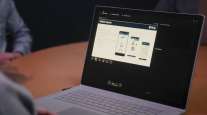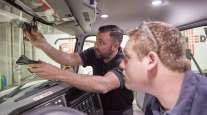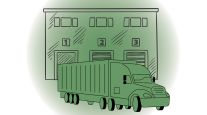iTech: Making Choices in In-Cab Technology
This story appears in the August/September 2009 issue of iTECH, published in the Oct. 14 print edition of Transport Topics.
Are you ready to order? To purchase in-cab technology for an entire fleet, placing the order could be the least complicated part of the process, as simple as picking from the menu of a fast-food restaurant.
Making sure you get just what you want, however, requires methodical research and meticulous evaluation before making your choices.
“It’s a huge investment, so you want to be diligent about how you move forward with it,” said Barry Craver, director of freight processing applications for Old Dominion Freight Line, Thomasville, N.C.
Old Dominion had plenty of technology in its system: voice-activated and computer-based customer access to shipment status and billing, electronic tag readers on all dock equipment, and handhelds for pickup and delivery. But an in-cab, driver-focused computer was going to be something new for the 5,100-truck less-than-truckload company.
“Our safety folks had started looking at some way to do electronic logs” for the linehaul units, Craver recalled. The exploration quickly morphed into: “What else could we do if we were to put computers in our tractors?”
Most in-cab technology is sold to the truckload sector, yet interest among LTL carriers is growing a bit, as costs go down and service demands go up, said Ken Weinberg, vice president of Carrier Logistics Inc., a company that specializes in LTL freight-management software.
But it’s “not across the board — not as universal as in the truckload environment,” he added.
Vehicle-monitoring, for example, usually is not a priority, because LTL trucks run the same routes regularly. On the other hand, some LTL carriers are looking for help in managing fuel consumption by monitoring engine-idling and costly driving habits, such as hard braking and speeding — which also figure into the safety equation.
“When you have these units in place, the insurance companies look favorably upon it,” Weinberg said.
As director of safety and fleet services for a smaller trucking operation, Jim Corbean Jr. is a self-described one-man shop. He, too, was eyeing the future of electronic onboard recorders when he began researching in-cab technology for Orgill Inc. in 2006.
“There was a lot of attention on hours of service at that time, especially the idea of requiring hazmat carriers to have onboard logs,” Corbean said. “We felt, and I still feel, that we’re going to be required to have onboard [hours of service] recording. I didn’t want to be there when everybody was lining up trying to get it.”
Privately held Orgill, Memphis, Tenn., distributes products to hardware, home improvement and building material retailers in the United States and abroad. It has six distribution centers and two export consolidation facilities in the United States, served by its fleet of 220 tractors and 470 trailers domiciled at 28 locations.
Corbean and Orgill also had other operational efficiencies in mind. Besides automated log-keeping, they wanted a system that would provide trip reports; enable electronic compliance with state fuel taxes; display vehicle locations on a map; and allow exchanges of messages with drivers.
Craver had the resources of Old Domin-ion’s own information technology group for building a plan on how to go systems shopping. They carefully mapped out a process that spanned more than a year and a half, during which they interviewed 18 vendors in their search for a full-feature onboard computer.
The group developed a “requirements list” of features and functions, including asset-tracking, and sought input from would-be users in other departments within the company.
When discussing the Global Positioning System, the managers and IT people focused on what they wanted to be able to do with it right away — and what they might want to do with it some distant, or not-so-distant, day.
Craver recalled some of the questions about GPS: “Can we configure the GPS frequency polls? Can we use geofencing, land-marking, route-tracking history?”
These elements serve customers who want updates about shipment movements and automatic delivery notices.
The IT specialists also wanted USB ports on the fleet’s cab computers so that functions could be added in the future. And they wanted to know the likelihood that a vendor would grow to offer “other pieces, like trailer-tracking,” Craver said.
Given high importance, as a result of the in-house talks, was having more than one communication signal format — cellular and Wi-Fi were favored — and an interface between the cab computer and the engine computer.
Corbean’s methodology was similar, although the IT group at Orgill was an ad hoc assemblage. Technology objectives were identified with input from transportation managers and driver supervisors working at distribution centers.
“We conferred with them very heavily,” Corbean said. “We also interfaced some with our customer service department,” which put a premium on being able to monitor vehicle locations, the idea being that it would be able to respond to customers inquiring about deliveries en route.
To justify their substantial investments, both fleets wanted in-cab systems that provided multiple benefits. Craver said the key to choosing the right technology is knowing what you want it to do.
“You need to be open-minded to all that you possibly can — not that you’re going to do [everything] right out of the gate. You don’t want to select something that can’t grow with you.”
That’s why studying products and then conferring with vendors was essential.
“Technology by itself can be a complete waste of money unless you align it with your objectives,” said Brian McLaughlin, chief operating officer for PeopleNet, which ultimately won Old Dominion’s business. Installation of PeopleNet’s Blu was under way at this writing.
Orgill decided to go with a system supplied by Xata Corp. and finished installing it on all its tractors in 2008.
“Every company knows what it needs,” said Xata Corp. spokesman Karl Nilsson. “They may not necessarily always be able to articulate it to the technology providers, but if they sit down with them and discuss from a business process what their needs are, the technology needs start to fall in place.”
Buyers should investigate the bona fides of the companies they are considering buying from. Old Dominion questioned vendor candidates about their expertise in motor freight transport. Did they offer 24/7 support? How stable were they financially? Would they continue to be there to support their products?
And Old Dominion devised a scorecard to evaluate each vendor’s offering. Functions, features and services identified by the IT group as most important were graded as a “3,” while those deemed least important were rated “1.”
Of the dozen and a half vendors interviewed initially, six were invited to come back and make a presentation, with Old Dominion again keeping score.
This method allowed for the unexpected.
As Craver explained, “If one vendor came in with a feature that was really nice that we didn’t really account for and the other vendors didn’t have it, then that was a differentiator” and was rated according to the same 1-2-3 scheme. Text-to-speech was one such feature. Old Dominion decided to give it a value of “2.”
Some of the products had a serial port, to which users connect a USB device with a serial-to-USB dongle, Craver said. A dongle is a broadband wireless adapter, configured so as to protect the vendor’s software from attempts to copy it.
“That’s okay, but it’s not really a true USB port as far as speed goes,” Craver said. No “3” for that one.
From six presenters, Old Dominion narrowed the candidates to three. The fleet ran simultaneous pilot programs of the three finalists’ technology for 90 days. This process involved 10 tractors for each system. After the tests concluded, Old Dominion made its choice.
Such thoroughgoing process may not be feasible for every motor carrier, but those with fewer resources or less time can observe the fundamentals.
After numerous meetings with vendors, Orgill decided to test the Xatanet Web-based system. Five units from Xata were placed in service runs for six months “to see how they worked and get driver response,” Corbean said.
The testing cinched the deal, and the fleet decided to install the technology over a two-year period.
The phase-in was “partly for financial reasons” and partly because “we didn’t want to do it all at one time,” Corbean said.
He said getting everyone trained for a total rollout “would have been extremely difficult,” though he noted that the in-cab unit is simple and easy to use.
The model that Orgill installed is mounted on the dashboard and features a monochrome touch-screen display for scrolling the menu and entering numbers.
“I tell the guys, ‘If you can use an ATM, you can use this,’ ” Corbean said.
Other than a small number of cases in which energetic users jabbed too hard at the touchscreens, breaking them, and a “hiccup” with a server, the introduction proceeded smoothly.
Prices and costs, of course, are a major element in the equation. The bottom line extends beyond “how much” to “total cost of ownership,” Craver said.
The idea behind total cost of ownership, or TCO, is “to measure direct and indirect costs of an investment over time to determine its viability,” VDC Research Group, a consulting firm specializing in technology, wrote in a white paper on the subject.
Total cost of ownership consists of “hard” and “soft” costs, VDC said. On the hard side are prices of hardware, accessories and software, and implementation and training costs. Soft costs are more difficult to pin down, said the research firm, for they include productivity loss, opportunity loss and IT support, as well as costs of repairs and replacement parts.
Craver said Old Dominion determined during its in-house discussions that TCO also would include installation and implementation, training of users, warranty offered by the vendor, and projected payback or return on investment.
The accounting of costs should be balanced by any realized savings.
The biggest payoff so far for Orgill’s choice has been improved vehicle fuel efficiencies. The onboard computers feed operational data to fleet managers, providing such performance-analysis options as daily vehicle miles-per-gallon and idling time, “so we can see drivers’ habits,” Corbean said.
Most of the tractors in the Orgill fleet are tandem-axle day cabs used to make deliveries to 12 to 15 stores per day. “There’s a lot of stopping and going, a lot of idle time while the guy is unloading.” Corbean said.
Before installation of the in-cab system, the tractors averaged about 6 miles per gallon. Today, the average is 6.6 mpg, Corbean said, with the tractors at one distribution center hitting 6.8 mpg.
“We have been as high, as a company, as 6.7” mpg, he said.
On the other hand, electronic log-keeping has not been mandated — at least not yet.
On that score, Corbean said, “I may be a little too far ahead of the curve, but all the other benefits of the system have helped us, so we feel like we’ve made the right decision.”




